Este libro explora la intersección de la neuroética y el derecho digital en Iberoamérica, analizando cómo las tecnologías disruptivas están transformando conceptos jurídicos y éticos.
Referencia
97633
Ficha técnica
Autor
HERRERA-FERRÁ, KAREN; MUÑOZ, JOSÉ M.
Editorial
Aranzadi
Idioma
Castellano
ISBN
978-84-1085-385-0
Fecha de Publicación
10-11-2025
Nº de páginas
459
Encuadernación
Rústica
Nº edición
1





